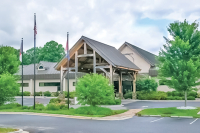Angling for attention: New fly-fishing shop hopes to fill void in Waynesville
When Matt Rosenthal opened the doors of a new fly-fishing shop in Waynesville last week, word spread quickly among the fishing community. All week, fishermen moseyed through the new Waynesville Fly Shop, sizing up the owner Matt Rosenthal as much as his wares.
Fishermen came through asking for obscure fly patterns to test his knowledge. One fisherman showed Rosenthal a fly, claimed he didn’t know what kind it was but said he wanted another one like it. Really he just wanted to see if Rosenthal could identify it.
Last Friday was no exception. First it was the local mail carrier, who brought the mail inside rather than leaving it in the door slot so he could take a gander through the shop. He was followed shortly by a local banker popping by on his lunch break, who plucked flies out of the bins and asked Rosenthal questions like “Have you ever tried the triangle taper?” And so it went for most of the day.
“They’re checking to see what patterns I’m stocking to see if I know what I’m doing,” Rosenthal said. “It is a very interesting process.” Local fly-tiers have also been stopping in to show Rosenthal their work in hopes he’ll buy from them.
Rosenthal decided to open the shop shortly after the well-known and much-loved Lowe’s Fly Shop closed down this summer. Lowe’s fly shop was a fly-fishing institution, known to fisherman across the Southeast largely due to the famed reputation of its owner, Roger Lowe, an expert fly-tier, fisherman and guide. Lowe is continuing his guide service, but has closed the retail shop.
Rosenthal hopes to fill the void.
Related Items
“All of a sudden there was this opening in the market, and I saw a real need for it in the community,” said Rosenthal.
Rosenthal had to act quick, however. He decided to open a shop, found a location and ordered merchandise in a matter of weeks.
“Right now the people I have met are amazingly supportive of the shop. I think because there’s a hole,” Rosenthal said. “This is a big part of the fly-fisherman’s world — getting together and talking to people about conditions, about what’s biting. There is a very community-oriented aspect to a shop.”
Like most entrepreneurs that turn their hobby into a business, Rosenthal is learning as he goes.
“I have no experience in retail. I’ll order stuff and then forget what I’m supposed to price it for,” Rosenthal said.
Rosenthal thinks there is a market for a fly shop in Haywood County. The next closest fly shops are in Cherokee, Cashiers and Asheville.
“They are all 30 miles away from here. This is a pocket with a tremendous number of fishermen and a lot of tourism that comes through Waynesville,” Rosenthal said.
These days, most of the merchandise in Rosenthal’s shop could be ordered off the internet. But it’s not the same, Rosenthal said.
“A tier who orders it off the Internet can’t handle it before they buy it,” Rosenthal said, pulling a bundle of roster feathers used for tying flies out of a package. “A good tier will examine the necks. They’ll roll the feathers. They’ll look for webbing. They will look for certain numbers of feathers in certain sizes.”
In terms of rods and gear, Rosenthal has a lawn behind the shop where people can cast with a rod and size up its feel before they decide to buy.
Rosenthal admitted the Internet is a threat to small shops, but hopes fishermen and fly tiers will support the physical presence of a fly shop in their community.
So far Rosenthal is the only one to step into the business since Lowe’s closed, but there is a rumor that someone else had a similar idea and could be working toward opening a second fly shop.
On the water
Rosenthal hopes the fly shop will be an outlet to his true passion: teaching the art of catch-and-release fly-fishing, especially to kids.
“I very much want to grow the sport. It is a wonderful activity.”
Rosenthal’s rapture with fly-fishing is clear when he describes the experience. Peace and serenity mixed with excitement and challenge — a connection with nature that transcends man and fish to something deeper.
“It’s one of the few activities for me where I’m at peace. There’s usually a hike involved, there’s wildlife, birds, all this stuff that is going on around you and you get the chance to chase this really pretty little fish,” Rosenthal said.
Trying to trick the fish into thinking the fly on the end of your line is an insect makes the connection that much deeper, Rosenthal said, especially when you’ve tied that fly yourself.
“It’s a craft and something that takes a lot of talent,” Rosenthal said of tying flies. “When you take that creation and try to coax the fish into biting it, it makes it that much more fulfilling.”
Rosenthal hopes to be an advocate for catch-and-release fishing.
“These streams can’t handle the pressure of all these people fishing,” Rosenthal said. “They constantly have to stock. I’m not against taking fish if you are going to catch them and eat them at a campsite, but the relentless pursuit of fish isn’t sustainable.”
Wild streams — the more secluded creeks where trout are mating and reproducing naturally instead of being stocked and instantly caught out — are coveted locations and rarely shared among fishermen. Catch-and-release fly-fishing is particularly important to keep those wild populations reproducing.
“You can set a wild stream back 20 years with a couple people with worms,” Rosenthal said. “With catch-and-release fly-fishing, that fish is there to be caught again by you or someone else. If you thump them and throw them in a bag, they’re gone forever.”









